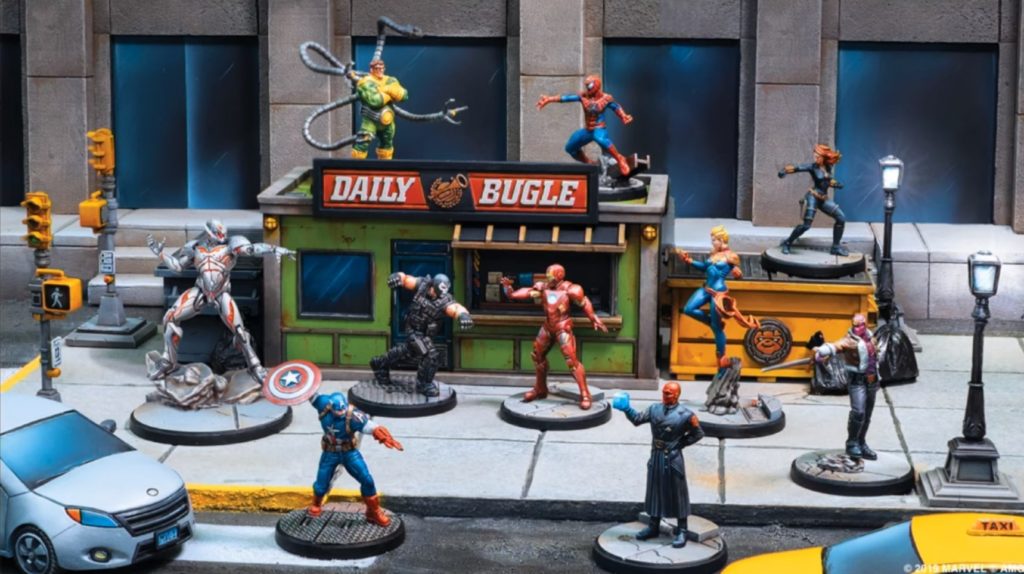The meta-game BEFORE the game, Marvel: Crisis Protocol begins with creating your pre-game roster.
Marvel: Crisis Protocol is absolutely exploding as a competitive game. Due in equal parts to its beloved IP, an accessible skirmish size, and some incredibly balanced rules, this game has quickly grown from a modest launch, to a top-tier, skill based, competition miniatures game. If you have played it, you already know its cleanly written rules are particularly suited to real tests of skill, but new or curious players may not realize how much nuance the game brings to the table.
For those players, or just to help sharpen the skills of existing players, here is the first of a series of articles looking to break down different aspects of the game, before eventually helping you bring it all together.
The Right Heroes for the Job:
Crisis Protocol combines conventional list-building with a concept common to several tournament games, the “side-board”. In essence, you bring a pool of heroes/villains as your “Roster”, but once the scenario is laid out you select from that pool to create your actual list for the game.
In practice, this means that you need to make meaningful choices before you left your house, before the game, and as scenarios are being revealed, with each choice shaping the game to come.
Let’s address the first of those choices… your initial roster.
A roster is generally ten models, though things like Infinity Gems may occupy some of these slots. At the most superficial of levels, this roster of ten allows you to be most familiar with a more modest pool of characters, even as it grows. With frequent no releases it can be challenging to learn every model’s usage. Beyond that, sometimes a favorite character will have a spot in your roster “just because”, which is as valid as any other reason.
Ultimately, I encourage players to learn a set roster, potentially promoting/demoting characters periodically. MCP really rewards skill and practice, and is very much a game where learning to make the absolute most of a character tends to yield better results than having a surface understanding of many, many characters.
When beginning to form a roster, looking at Affiliations are a decent starting point. Some very powerful bonuses await those who choose a majority of their game-time list from traditionally themed characters, and as these expand, many Affiliations now have enough diversity to create different playstyles.
Getting more free-form in your roster building requires considering some stock character roles, however.
Characters broadly fit into categories (or combinations of them). Black Panther is very mobile, and thus a strong objective grabber, though is also a commendable tank, able to endure hits.
If nothing else, when you think you have a rounded roster, give it one more pass and see if it has someone who looks to fill the following roles; a character assassin, a quick objective grabber/mover, a tank, a debuffer, someone that moves/manipulates model placement.
In the weeks ahead we’ll discuss these at greater length, but a quick look at your character cards will pretty clearly indicate who falls into which categories.
Also, if you happen to play video games like Dota or League of Legends, this process might feel very familiar.
The Player Across from You:
Player rosters are not hidden information, and the gamesmanship begins as soon as you sit across from your opponent. Very real strategies might include bringing bait characters in your roster, that call for hard counters, even if you have no intent to use them.
For example, MODOK is a notoriously killy, character assassin. A player opposite you may be inclined to counter-pick with a character like Killmonger, intended to destroy MODOK before his power-pool gets up to the level needed to really be a threat. If, however you never planned to field MODOK, you may have just won a preliminary psychic battle before the game even began.
Likewise, having answers for certain models can be useful. Thor is a common sight (as is likely the soon to be released Angela), as he has a lower skill ceiling, and can be powerful even in the hands of newer players. Knowing this might mean bringing your preferred anti-Thor tech, whether with an assassin, more numerous fodder/distraction picks, etc…
Being mindful of over-all damage types should be a factor as well. A roster filled with physical attackers might have fits dealing with Venom, while Doctor Strange or Ghost Rider will just eat his lunch. Bringing a blend of physical, energy, and mystical attackers will also help give you flexibility once you have seen what your opponent has.
Game Time:
We will talk about building your roster with scenarios in mind down the road, but for now know that you will only be able to control half of what the mission entails, regardless. This is another area in which practice with one rosters will do you wonders. Sometimes this is obvious. If Daemons attack, an Incinerate-immune model, or models who easily clear conditions can be a huge asset.
This simply comes with time, but again, flexibility and experience are your best bet. If tasked with picking up an objective that requires rolling energy defense successes, maybe don’t bring Hulk.
A Game within a Game:
Meta-play is always a bit of an art that raises a player’s performance, but also requires a finesse that is difficult to teach. Do your local players have crutch characters, or fall victim to certain tactics more than others? These kinds of pieces of info just have to be felt out.
So find your favorite characters, start rounding out a roster, and tell me below, which characters you most want to learn about! Next time, we are going to be talking about Tactics cards, as well, the often unsung parts of a great list, and a winning strategy!
And remember, Frontline Gaming sells gaming products at a discount, every day in their webcart!

